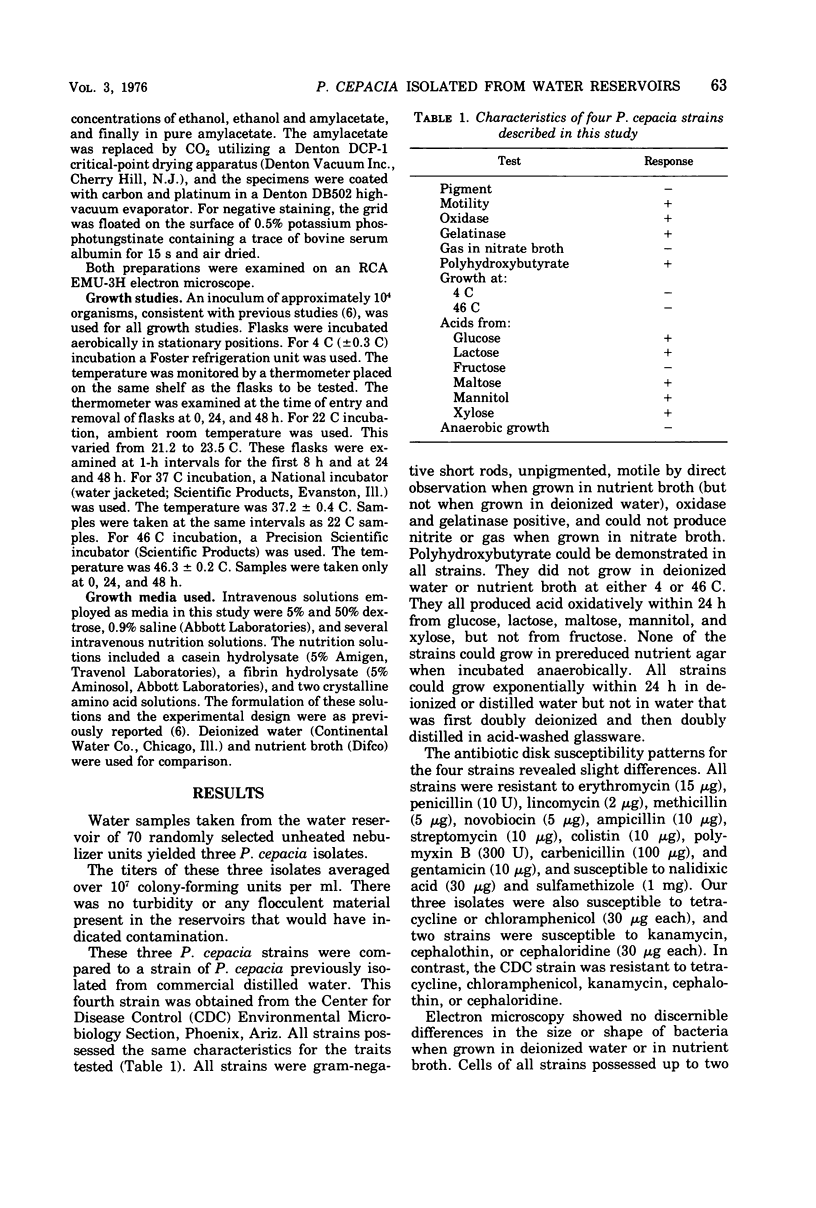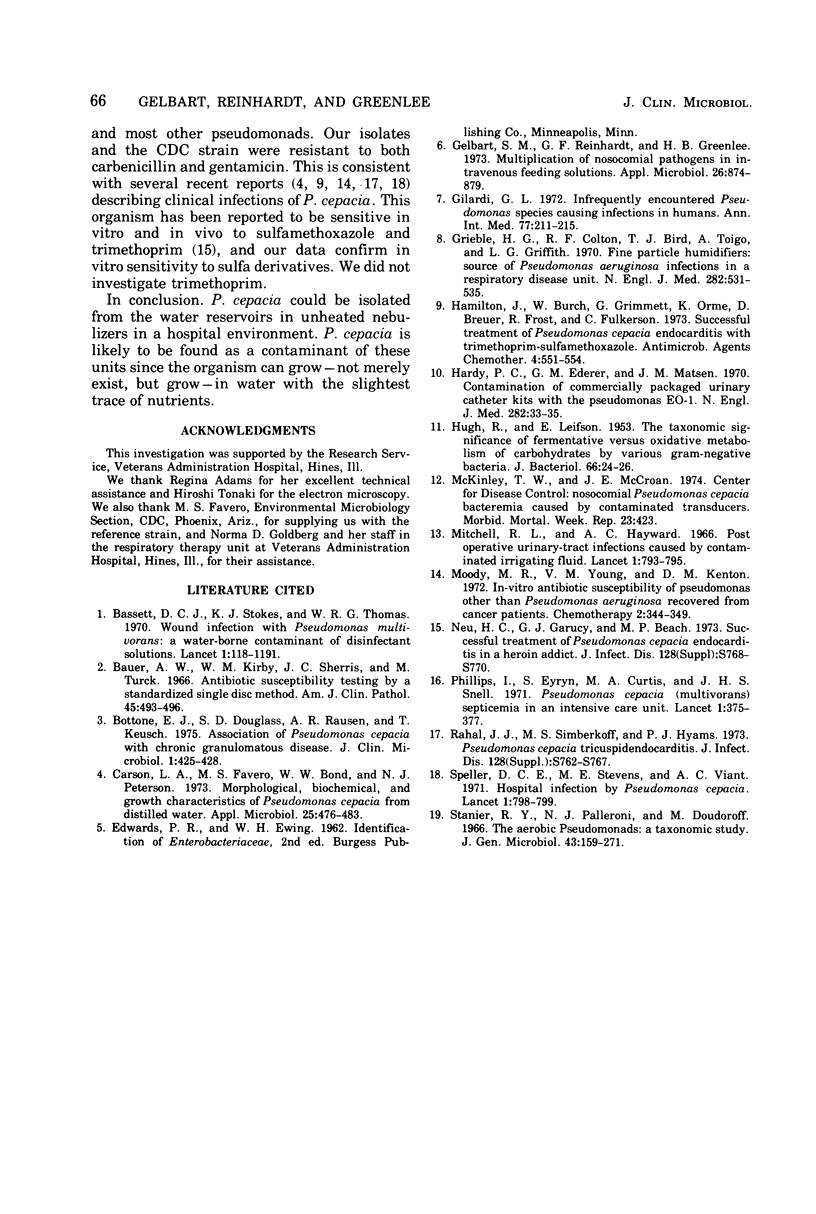Abstract
Pseudomonas cepacia strains were isolated from the water reservoirs of unheated nebulizers in a hospital setting. The isolates were characterized by morphology, biochemical tests, and antibiotic susceptibility patterns. An interesting feature of these organisms was their capacity for sustained multiplication in either doubly deionized or doubly distilled water as well as 5% dextrose or 0.9% saline. They could not multiply in doubly deionized and then doubly distilled water or in any of several parenteral nutrition solutions studied. Isolation of Pseudomonas cepacia from the water reservoirs of unheated nebulizers suggests that this equipment may serve as a source of respiratory tract exposure to the organism.
Full text
PDF




Images in this article
Selected References
These references are in PubMed. This may not be the complete list of references from this article.
- Bassett D. C., Stokes K. J., Thomas W. R. Wound infection with Pseudomonas multivorans. A water-borne contaminant of disinfectant solutions. Lancet. 1970 Jun 6;1(7658):1188–1191. doi: 10.1016/s0140-6736(70)91783-6. [DOI] [PubMed] [Google Scholar]
- Bauer A. W., Kirby W. M., Sherris J. C., Turck M. Antibiotic susceptibility testing by a standardized single disk method. Am J Clin Pathol. 1966 Apr;45(4):493–496. [PubMed] [Google Scholar]
- Bottone E. J., Douglas S. D., Rausen A. R., Keusch G. T. Association of Pseudomonas cepacia with chronic granulomatous disease. J Clin Microbiol. 1975 May;1(5):425–428. doi: 10.1128/jcm.1.5.425-428.1975. [DOI] [PMC free article] [PubMed] [Google Scholar]
- Carson L. A., Favero M. S., Bond W. W., Petersen N. J. Morphological, biochemical, and growth characteristics of pseudomonas cepacia from distilled water. Appl Microbiol. 1973 Mar;25(3):476–483. doi: 10.1128/am.25.3.476-483.1973. [DOI] [PMC free article] [PubMed] [Google Scholar]
- Gelbart S. M., Reinhardt G. F., Greenlee H. B. Multiplication of nosocomial pathogens in intravenous feeding solutions. Appl Microbiol. 1973 Dec;26(6):874–879. doi: 10.1128/am.26.6.874-879.1973. [DOI] [PMC free article] [PubMed] [Google Scholar]
- Gilardi G. L. Infrequently encountered Pseudomonas species causing infection in humans. Ann Intern Med. 1972 Aug;77(2):211–215. doi: 10.7326/0003-4819-77-2-211. [DOI] [PubMed] [Google Scholar]
- Grieble H. G., Colton F. R., Bird T. J., Toigo A., Griffith L. G. Fine-particle humidifiers. Source of Pseudomonas aeruginosa infections in a respiratory-disease unit. N Engl J Med. 1970 Mar 5;282(10):531–535. doi: 10.1056/NEJM197003052821003. [DOI] [PubMed] [Google Scholar]
- HUGH R., LEIFSON E. The taxonomic significance of fermentative versus oxidative metabolism of carbohydrates by various gram negative bacteria. J Bacteriol. 1953 Jul;66(1):24–26. doi: 10.1128/jb.66.1.24-26.1953. [DOI] [PMC free article] [PubMed] [Google Scholar]
- Hamilton J., Burch W., Grimmett G., Orme K., Brewer D., Frost R., Fulkerson C. Successful treatment of Pseudomonas cepacia endocarditis with trimethoprim-sulfamethoxazole. Antimicrob Agents Chemother. 1973 Nov;4(5):551–554. doi: 10.1128/aac.4.5.551. [DOI] [PMC free article] [PubMed] [Google Scholar]
- Hardy P. C., Ederer G. M., Matsen J. M. Contamination of commercially packaged urinary catheter kits with the pseudomonad EO-1. N Engl J Med. 1970 Jan 1;282(1):33–35. doi: 10.1056/NEJM197001012820108. [DOI] [PubMed] [Google Scholar]
- Mitchell R. G., Hayward A. C. Postoperative urinary-tract infections caused by contaminated irrigating fluid. Lancet. 1966 Apr 9;1(7441):793–795. doi: 10.1016/s0140-6736(66)91866-6. [DOI] [PubMed] [Google Scholar]
- Moody M. R., Young V. M., Kenton D. M. In vitro antibiotic susceptibility of pseudomonads other than Pseudomonas aeruginosa recovered from cancer patients. Antimicrob Agents Chemother. 1972 Nov;2(5):344–349. doi: 10.1128/aac.2.5.344. [DOI] [PMC free article] [PubMed] [Google Scholar]
- Phillips I., Eykyn S., Curtis M. A., Snell J. J. Pseudomonas cepacia (multivorans) septicaemia in an intensive-care unit. Lancet. 1971 Feb 20;1(7695):375–377. doi: 10.1016/s0140-6736(71)92212-4. [DOI] [PubMed] [Google Scholar]
- Speller D. C., Stephens M. E., Viant A. C. Hospital infection by Pseudomonas cepacia. Lancet. 1971 Apr 17;1(7703):798–799. doi: 10.1016/s0140-6736(71)91236-0. [DOI] [PubMed] [Google Scholar]
- Stanier R. Y., Palleroni N. J., Doudoroff M. The aerobic pseudomonads: a taxonomic study. J Gen Microbiol. 1966 May;43(2):159–271. doi: 10.1099/00221287-43-2-159. [DOI] [PubMed] [Google Scholar]



